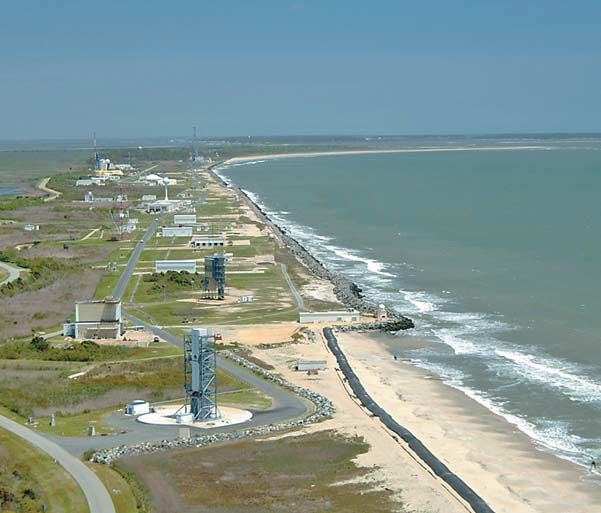Rising seas threatening NASA launch centers
By Agence France-Presse in Washington (China Daily) Updated: 2014-05-21 07:10|
The Wallops Flight Facility in Virginia is one of several NASA facilities under threat from rising sea levels due to global warming. NASA is building sea walls to prevent encroachment. Provided by NASA |
Many complexes have suffered damage from encroaching water
The rise in sea levels is threatening the majority of NASA's launch pads and multibillion-dollar complexes famous for training astronauts and launching historic missions to space, scientists said on Tuesday.
From Cape Canaveral in Florida to mission control in Houston, the US space agency is busily building seawalls where possible and moving some buildings further inland.
Five of seven major NASA centers are located along the coast. Experts say that proximity to water is a logistical necessity for launching rockets and testing spacecraft.
Many NASA centers have already faced costly damage from encroaching water, coastal erosion and potent hurricanes, said a report by the Union of Concerned Scientists.
Perhaps the most iconic launch pad lies in Florida at the Kennedy Space Center, the liftoff point for the Apollo missions to the moon and many space shuttle flights over the past three decades.
"According to NASA's planning and development office, rising sea levels are the single largest threat to the Kennedy Space Center's continued operations," said the report, which also listed other historic sites across the United States that are threatened by sea level rise.
They include the Statue of Liberty in New York, the first permanent British colony in North America at Jamestown Island in Virginia, and historic Charleston, South Carolina.
One key NASA site that is succumbing to rising seas is Wallops Flight Facility in Virginia, where 16,000 rockets have launched and where sea levels have surged 23 centimeters since it opened in 1945.
Others are Ames Research Center in San Francisco and Langley Research Center in Virginia, which is a $3.5 billion facility with specialized wind tunnels for simulating flight.
"Retreat is the way to go here, because you just can't like, get up and move. The infrastructure is too great here," said Russell De Young of the NASA science directorate at Langley.
"They are tearing down buildings that are at the water's edge and building new structures as far back as we can against the fence of the property line," he said.
The new complex is aptly named "New Town".
De Young is among a handful of NASA employees who are tasked with monitoring climate change and analyzing the impact it would have on NASA facilities.
US President Barack Obama called on all government agencies in 2009 to take steps to prepare for climate change.
De Young said the space agency, like other government facilities that find themselves on the coast, are trying to make incremental changes over the coming decades.
"This is not imminent," he said, noting that the forecast at Langley, which is in Hampton, Virginia, sees 30 cm of sea level rise from the 1980s until the year 2100.
"With sea level rise you can always manage it, but if a hurricane hits us, that is what worries us. The combination of the two is a devastating blow that we dread."











